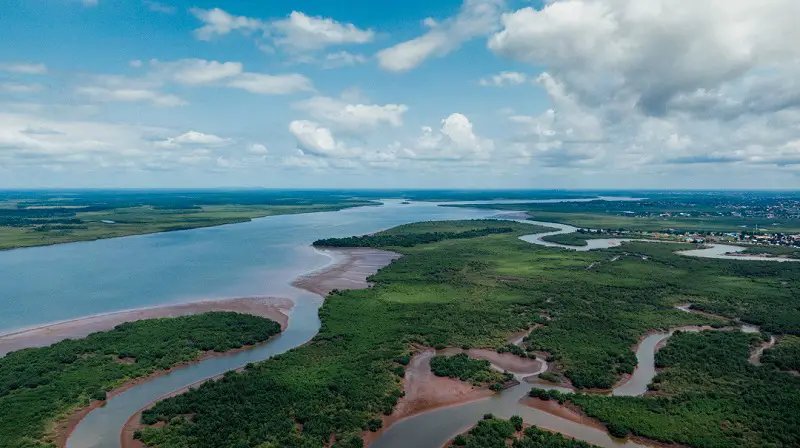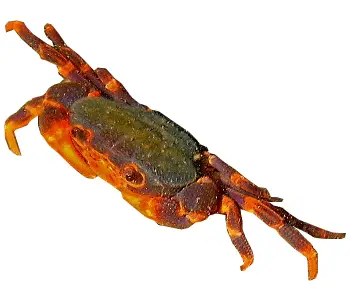There are very few references on the biodiversity in freshwater and estuarine ecosystems of tropical countries. Students, therefore, are not able to appreciate the differences between these two ecosystems. Most of the published literature are descriptions of freshwater and estuarine ecosystems in temperate regions. In recognition of this information gap, this article provides an overview of the two ecosystems and contains links to detailed descriptions of freshwater and estuarine ecosystems in Puerto Princesa, Palawan.
Why the Dearth of Literature on Freshwater and Estuarine Ecosystems?
Information on freshwater and estuarine ecosystems of tropical regions is lacking. It may be due to the lack of regard to the critical role these ecosystems play in people’s lives in communities or cities. It may also be due to the inability of educators in many tropical countries to develop and publish material in tune with their local settings.

Estuarine ecosystems have high levels of biodiversity.
Many of the teachers are still locked in their traditional modes of teaching. They are occupied with classwork and regular lecture sessions, limited by their four-cornered classrooms. Or probably, they have devoted themselves to economic activities to keep up with the ever-growing prices of goods and services.
Whatever the reason, the point is that many students in tropical countries learn from the books published by authors in other places, which may not be relevant to their specific location. There should be a change in paradigm among teachers.
Recognizing this, I always take the opportunity to engage my environmental science and marine biology students in fieldwork as I teach subjects that require them to go to the field and explore the environment. It may be a Dynamics of Ecosystems course or the subject Research 01, where they need to familiarize themselves with actual research situations, i. e., in the field. I always attempt not to teach them but mentor them along the way.
Let them discover – so to speak.
Field Trip to Freshwater and Estuarine Ecosystems
There were two separate occasions of fieldwork that I undertook with my students to get familiar with these ecosystems. These are
1) a trip to the freshwater ecosystem of Balsahan by graduate students enrolled in the Dynamics of Ecosystems course, and
2) a recent trip to the estuarine portion of Iwahig River.
Freshwater Ecosystem of Balsahan
We discovered a very diverse array of wildlife in the upper freshwater portion of the Balsahan River. Among these is a species of Insulamon, a crab endemic (or only found) to Palawan.

We surveyed in 2010, but then references on proper identification of the crab are not available, so we could not identify it correctly. No taxonomist was also available for consultation at that time. What we lack in taxonomic skills we compensate by taking a photo of the crab for future reference.
Eventually, Dr. Hendrik Freitag, animal ecologist of Ateneo de Manila University, identified the crab as Insulamon palawanense in 2012. It was featured in the National Geographic Online Magazine. Dr. Freitag happened to visit Palawan State University and saw the picture in one of my online articles. He confirmed the crab indeed belongs to the same species he discovered.
We saw a small, almost inconspicuous leaf frog, even an endemic species, hiding under the leaves along the riparian zone of Balsahan River. This funny looking frog has skin that protrudes like horns on its head.
Estuarine Ecosystem of Iwahig River
Estuarine ecosystems are also not well studied in tropical regions, especially in the unique Island of Palawan, which has wildlife species in more affinity with nearby Borneo Island than the rest of the Philippines. Experts attribute this similarity to land bridges that connect mainland Palawan with Borneo.
Despite the itchy bites of the sandfly (local name: niknik), marine biology students braved the waist-deep waters near the Iwahig River’s mouth. Many species of wildlife were photographed and then released back into the water. Likewise, we identified the mangroves growing in the estuarine portion of the river.
Notable among the animals is another crab of purple color. Is it another Insulamon? We don’t know because no information on a crab with such appearance is available. Proper identification requires a considerable number of crabs, some measurements, and a whole lot of descriptions filled with jargon. The picture says it all anyway.
The trip lasted only for about two hours, but we collected a diverse collection of photographs on the biodiversity of the estuarine ecosystem. This collection is better than any book published in printed format.
© 2012 October 27 P. A. Regoniel
(updated August 19, 2020)
